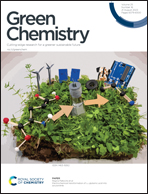Self-healing and reprocessing of reclaimed rubber prepared by re-crosslinking waste natural rubber powders†
Abstract
Efficient and sustainable disposal of waste rubber remains an extreme challenge worldwide due to the huge quantities and non-biodegradable structures. Although many self-healable and reprocessable rubbers have been designed to overcome the challenge, these rubbers are elaborately synthesized and still industrial waste rubbers are not reutilized in their synthesis. Herein, waste natural rubber powders (WNRPs) are re-crosslinked by disulfide bond-containing polysulfide rubber (PSR) via a thiol–ene reaction to produce a self-healable and reprocessable reclaimed rubber. Increasing the PSR content is beneficial for conversion and crosslinking density, but it decreases mechanical properties. The produced reclaimed rubber can self-heal its damage at 100 °C for 24 h, and the recovery of mechanical properties is more than 90%. Moreover, the reclaimed rubber is still reprocessable at 100 °C for 12 h, and the recovery of mechanical performance exceeds 95%. More importantly, both virgin and self-healed and reprocessed reclaimed rubbers can withstand the repeated running over of a 2.0-T automobile, and the weight loss is less than 0.2% after 200 times. Therefore, this self-healable and reprocessable reclaimed rubber not only is synthesized by reusing huge amounts of waste rubbers, but also exhibits wide applications in damping materials due to its low cost.



 Please wait while we load your content...
Please wait while we load your content...